As the capital of China, Beijing has always been the first stop for many foreign tourists to China. Beijing has convenient transportation, with two airports and three railway stations, which allows tourists to travel from Beijing to any Chinese city they want to go to. The China tours starting from Beijing also account for a large part of all China tour itineraries. Today we will take you from Beijing to Xi'an, Chengdu and Shanghai. And this also includes a three-day Yangtze River cruise itinerary. After experiencing the history and culture of Beijing, you will experience Chinese fashion, development, food and natural beauty in other cities. Join this 13 days China tour from Beijing, you will get the chance to discover a real China in person. Don’t hesitate and book it now!

Welcome to Beijing, the starting point of your 13 Days Best China Tour. When you arrive at Beijing airport, your tour guide will hold your name sign, so you can easily find him/her in the airport arrival hall. Then your guide will send you to downtown Beijing and help you check in at the hotel. The rest of the day is arranged according to your wishes. Since you would have traveled for a long-distance, you’re recommended to have a nice rest in your hotel. But if you still feel excited and can’t wait to have close contact with the city, you can go around here.
Beijing, also known as Peking, is an ancient capital with a history of more than 3000 years. It is located in Northern China and is under the direct administration of the State Council. The city embraces multiple functions as it is the hub for culture, diplomacy, politics, economics, and education in China. Meanwhile, it is also home to most of China’s large state-owned companies and the two best universities (Tsinghua University and Peking University) in the Asia-Pacific area. When it comes to the architecture styles here, three main categories are the most predominant ones. Tian’anmen Gate Tower that you will visit tomorrow belongs to the first category: the traditional architecture of imperial China; then there’s the new Chinese style which means the boxy structures built between the 1950s and the 1970s with Chinese element design; thirdly, we can see most buildings in modern architectural forms, like the new CCTV Headquarters. The city has a monsoon-influenced humid continental climate, which means that here is hot and humid in summers, cold and dry in winters.
Option: If you want to go shopping at night, Wangfujing Street is a good choice. In the Qing Dynasty (1636 -1912), a well with sweet water was discovered hereafter ten aristocratic estates and princess residences were built. Therefore, the street got its name as “Wangfu”(princely residence) Jing” (well). Along this street, you will have a chance to taste many authentic local foods. You can also go shopping here as it is now home to nearly 280 shops including some malls like Beijing Mall and Beijing Department Store.
Today your journey in Beijing officially begins. After breakfast, your guide will take you to visit Tian’anmen Square. It is located near the city’s Central Business District and named after Tian’anmen Gate Tower (the boundary between the Forbidden City and Tian’anmen Square). Tian’anmen Square witnessed some important events in China. In 1949, Chairman Mao Zedong announced the founding of the People’s Republic of China right here. The large-scale military parade is also held in Tian’anmen Square, attracting countless visitors. Here you can see the Great Hall of the People, the Monument to the People’s Heroes, and the National Museum of China.
After visiting Tian’anmen Square, you will enter the Forbidden City (closed each Monday). It is a palace complex surrounded by a moat. Built in 1406, it was completed in 1420. The Forbidden City served as the imperial palace and winter residence of the emperors of China between 1420 and 1924. Nowadays, Chinese people call it Gugong, meaning the “Former Palace”. Its design, from the overall layout to the smallest details, reflects the majesty of imperial power. For example, as yellow symbolizes the emperor in ancient China, almost all roofs here are yellow glazed tiles. While traveling here, you may notice that there’re a lot of water tanks, which are regarded as mascots nowadays, so visitors like touching them with a wish to have good luck. In fact, the real purpose for placing these 308 water tanks is for extinguishment: the construction materials of the overall Forbidden City are basically wooden materials. In the dry season or when man-made arson occurs, it is easy to form a conflagration. This is where the large water tanks perform their important function, which is to prevent the fire from spreading faster.
After lunch, you will visit Summer Palace, an imperial garden in the Qing dynasty (1636-1912). It is inspired by the gardens in South China and has over 3,000 various Chinese ancient buildings housing a collection of 40,000 sorts of historical relics from various dynasties. In 1998, UNESCO declared the Summer Palace as “a masterpiece of Chinese landscape garden design” and was listed on the World Heritage List. There’re many scenic spots in the Summer Palace, and Long Corridor may attract your attention. It is a covered walkway first erected in the middle of the 18th century. The corridor is 728 meters long, and there are four octagonal pavilions (symbolize the four seasons) with double eaves here. On the beams and the ceilings of the Long Corridor, you can see many paintings which are themed in Chinese classical literature, folk tales, and famous Chinese buildings. One painting shows seven passionate who are known as the Seven Sages of the Bamboo Grove. Back then they composed poetry, music to entertain themselves rather than pursue the mainstream interests like fame and wealth.
Option: If you are interested in the Chinese Kungfu Show, you can go to Red Theatre at night. The building of the theatre is blended Western and Japanese architectural styles. Here you can watch the Legend of Kung Fu Show. Usually, the show will begin at 19:30, and each show will last 1.5 hours. In peak seasons, there will be an additional show at 17:15.
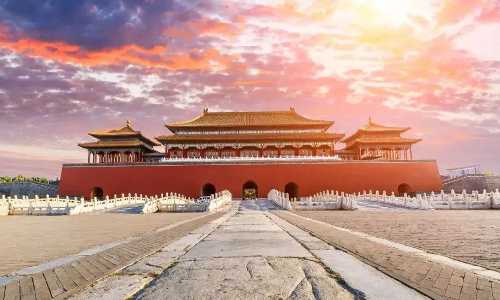
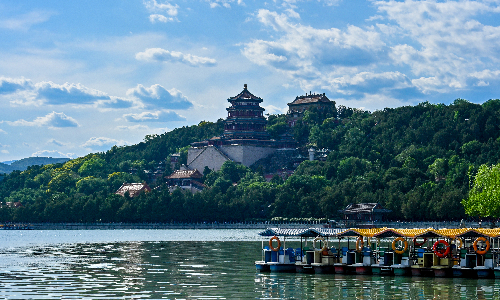
In the morning, you will have breakfast at your hotel. Then your tour guide will drive you from your hotel (in the urban area) northeast to Sacred Way first, and it will take about 1 hour (44km) to get there. Sacred Way is the road leading to the royal tomb. Along the Sacred Way, there are decorated stone statues including those in human figures, animals like lions and elephants, a mythological unicorn Xiezhi, and Kylin which is one of the four divine animals in ancient China. These animals are endowed with certain meanings: the lion and Xiezhi are the guardians of the tombs; Kylin is a benevolent beast in legends and symbolizes good luck, and camel and elephant are regarded as faithful animals and can travel long distances with heavy loads.
Then your guide will drive you from Sacred Way north to Ding Tomb. It is one of the thirteen imperial Ming tombs. It was built in 1584 and completed in 1590. Emperor Wanli and his two empresses were buried here. Ding Tomb was excavated in May 1959. Over 3000 cultural relics were found in the underground palace including the exquisite golden crowns. The general layout of the underground palace is square in the front and round in the back. That reflects the concept of the round sky and square earth in ancient China. Until now, Ding Tomb is still the only tomb that has been excavated of the thirteen Ming Tombs. Then your guide will take you to have lunch.
In the afternoon, you will move to the next scenic spot: Mutianyu Great Wall. It will take 1 hour 10 minutes (43KM) to drive from Ding Tomb northeast to the Great Wall. It is a time-honored Great Wall with high vegetation coverage. As the longest part of the Great Wall in China, it is also one of the famous sixteen scenic spots in Beijing. Because of Mutianyu's important geographical location in defending Beijing, the capital of the Ming Dynasty (1368-1644), and the Ming Emperor's Mausoleum, there have been many wars in history. Mutianyu Great Wall has its unique characteristics such as densely placed Watchtowers, outer and inner parapets crenelated with merlons. You will see crenels on both sides of the Great Wall which means soldiers can fight on both sides together while on other sections of the Great Wall, there are only crenels on one side. You can choose among cable cars, chair lifts, and toboggans of ascent and descent. For senior tourists, you are recommended to take cable cars considering safety. If you are a physically dexterous person, a chairlift is a better choice of ascending and descending. And toboggan is a more interesting and thrilling way to go down the hills.
After that, we will drive back to the hotel.
Options: If you want to hang out at night, you can go to Sanlitun Bar Street by yourself. It is located near the embassy area. As a fashion center, Sanlitun Bar Street gathered many shopping malls, cinemas, bars, and nightclubs, etc. You may also see many indoor art galleries, fashion shows, and photography exhibitions. It is one of the most popular places among young persons.
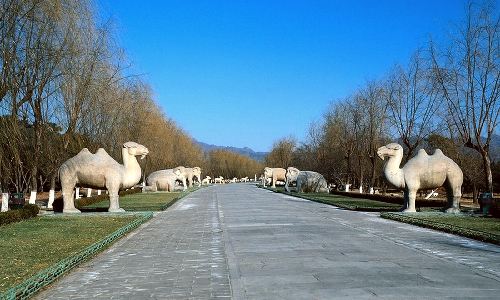
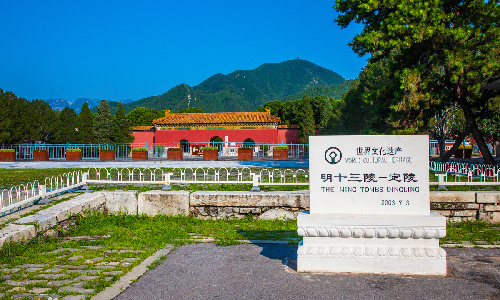
 Xi’an
Xi’an Today Temple of Heaven is waiting for your visit! Located in the south of Beijing, it is an imperial complex and served for Emperors in Ming (1368-1644) and Qing (1636-1912) dynasties to pray for a good harvest. The Temple includes three main groups of constructions: the Hall of Prayer for Good Harvest, the Imperial Vault of Heaven, and the Circular Mound Altar. When you are standing in the Hall of Prayer for Good Harvest, with careful observation, you will notice that there are four pillars at the inner part and twelve pillars at the outer part. They separately represent the four seasons and twelve months. And other sophisticated designs are waiting for you to discover! In addition, you will also see local people practicing Tai Chi, playing poker here, and if you want to have a try, you can ask them to teach you!
Then you will visit Old Beijing Hutong. Old Beijing Hutong involves narrow alleys formed by lines of Siheyuan (traditional courtyard residences mainly in Beijing). Have you ever heard that each Hutong has a name? In fact, some even had several names throughout their history. And many hutongs were named after their location or landmarks. When you traveling here, you can take a rickshaw, but most of the rickshaw drivers cannot speak English. Thus, to learn more details about hutong, your tour guide will lead you to a Siheyuan in the Hutong, where you can listen to the stories that happened in old Beijing. Because hutong is not far from the Forbidden City, some people who used to live here worked in the royal palace. Therefore, the host of Siheyuan now may be the descendants of imperial cooks, and some are descendants of court guards.
Then your guide will bring you to have lunch. In the afternoon, you will take the estimated train G349 15:13/19:42 to Xi’an. When you arrive at the Xi’an High-Speed Train Station, your guide in Xi’an will pick you up and send you to your hotel. Your guide will also help you handle the check-in. After that, you can have a nice rest and save your energy for tomorrow’s trip!
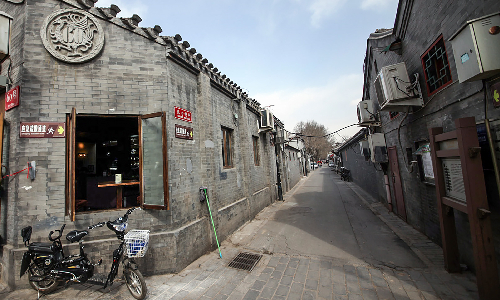
After breakfast, your guide will drive you from the downtown east to Terracotta Warriors and Horses Museum in 51 minutes (47.9 km). Although the present terracotta warriors and horses are all in drab colors, they had bright and harmonious paintings originally. But they faded when they came into contact with air. You can see about 7,000 terracotta warriors in the museum. But if you observe carefully, you will find the subtle differences in face, hairstyle, posture among those warriors. The discovery of these precious relics was out of coincidence. In March 1974, a villager named Yang Zhifa in Xiyang Village (east of the Mausoleum of Emperor Qin Shihuang) was digging wells for drought relief, then he found many fragments of the terracotta army. Then after the excavation of the workers, the Terracotta Warriors, and Horses buried under the ground more than 2,000 years ago finally showed up.
After lunch, you will go to the next destination: Big Wild Goose Pagoda. Built in 648, it serves to hold sutras and Buddha statues which were brought by Master Xuanzang from India to China. And it is Master Xuanzang who presided over the construction of the pagoda. About the origin of the Big Wild Goose Pagoda, there is a legend. One day, on his way to India, Xuanzang passed through a desert and got lost there. He was very tired and had no food and water left, but he still sat on his knees to read scriptures. Then a wild goose came and led him to find the water source. Finally, he got out of the desert and carried great gratitude towards the wild goose. When he returned to China, he built this pagoda and named it Big Wild Goose Pagoda.
Then you will go to visit the old City Wall, one of the largest and best-preserved Chinese city walls. City Wall was built as a fortified high wall around Xi’an city. Because of this strong City Wall, the old Xi’an city inside was well-preserved. Standing on the City Wall, you can see the old Bell Tower and Drum Tower. You can also see many people riding on the City Wall if you are interested, you just need to spend some extra fee and then you can get this experience.
Today’s tour comes to an end. You will be transferred to the hotel. Have a good rest.
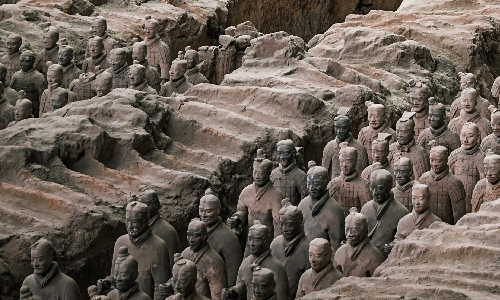
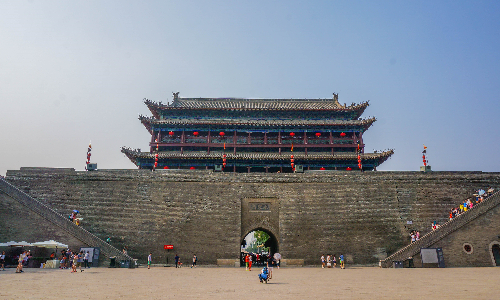
On the sixth day of your tour, you will first visit Shaanxi History Museum (closed on each Monday) after breakfast. The museum houses over 370,000 items, including ancient coins, bronze objects, murals, pottery, and so on. Here you can see the ancient chimes, an ancient Chinese musical instrument. It is a symbol of power and wealth in ancient China. At that time, people in the noble families will ring the chimes first before having meals.
And then we will go for lunch.
In the afternoon, you will visit the Great Mosque of Xi’an, one of the largest mosques in China. It houses over twenty buildings and five courtyards. The mosque combined Chinese architectural layout and Muslim decoration which looks imposing. Nowadays, it serves as a place for Muslims to worship. Its main hall can accommodate 1,000 people, but non-Muslim is not allowed to enter the prayer hall.
Then you will visit Muslim Quarter, home to over 20,000 Muslims. Here you can taste the Muslim food and buy some souvenirs. The street is famous for its various local snacks including Biang Biang Noodles, Zenggao (steamed rice cake with red dates), Roujiamo (Chinese Hamburger), and so on. Now it’s necessary to introduce Biang Biang noodles. The character “Biang” is onomatopoeic, imitating the sound of dough hitting the chopping board. So, from the name, you can imagine that the noodles are very chewy. Biang Biang noodles is a bowl of thick noodles drenched with hot chili oil and vinegar. When you eat these noodles, you can also try to add some onions and garlic. That will be much more delicious.
Option: At night, you can visit Grand Tang Mall. Based on the culture in Tang Dynasty (618-907), it is a cultural block that integrates shopping, catering, entertainment, relaxation, and tourism. On the central axis of Grand Tang Mall, there are nine groups of sculptures, including the emperor, historical heroes, and other themed statues. While traveling here, you can search for related stories about these historical figures. Sometimes you can even see some excellent performances on the street. Most of the actors wear the Tang Dynasty costumes which are ornate.
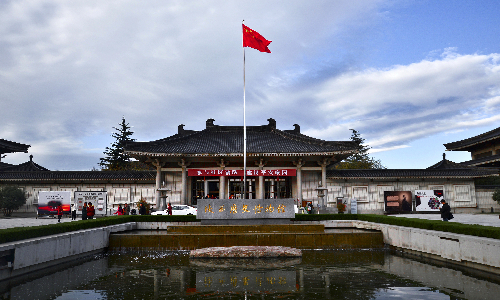
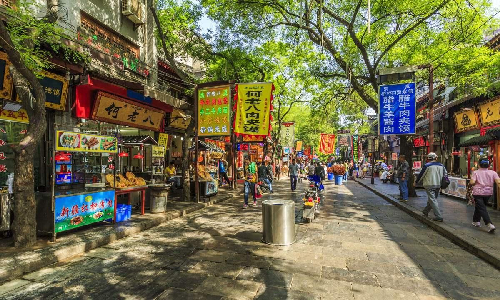
 Chengdu
Chengdu After breakfast, you will take the estimated train G2855 08:09/11:53 and move on to another city, Chengdu. Then your Chengdu tour guide will pick you up at the train station, and take you to have lunch.
In the afternoon, People’s Park is waiting for you! Built in 1911, the urban public park features several gardens, an artificial lake, the Heming Teahouse, and the Railway Protection Movement Monument (a Major Historical and Cultural Site of China). After enjoying the scenery in the park, taking a break and drinking a cup of tea in the Heming Tea House will be a good choice.
Then you will visit Jinli Street, where the traditional weddings, folk music performances, Sichuan Opera performances, and folk costume shows are regularly held. When traditional Chinese festivals are coming, visitors will see related activities like eating Zongzi contests in the Dragon Boat Festival. On this street, the essence of life in Chengdu is revealed. Tasting some local snacks and selecting some souvenirs for your friends here are good choices. It’s worth mentioning that the nightlife here is getting increasingly famous with the integration of catering, cultural creation, and cultural performances. So if you want to see a different Chengdu, you can come here again after dinner.
And then you will be transferred back to your hotel.
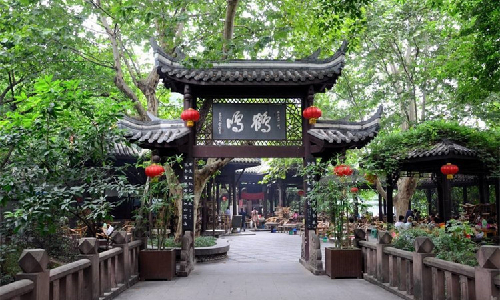
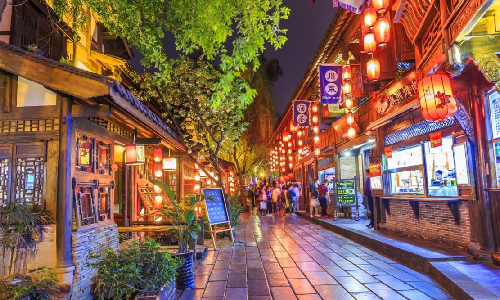
 Chongqing
Chongqing On the eighth day of your trip, you will continue exploring a well-known scenic spot in Chengdu: Chengdu Research Base of Giant Panda Breeding. It is built to conduct research and breed giant pandas and other rare animals. The chubby giant pandas, with their round ears and black and white fur, have won the love of people around the world. Pandas are active in the morning, so it's better to see them in the morning. In the base, you can not only interact with giant pandas, but also learn the related knowledge about giant panda reproduction, breeding, and the main food of pandas.
After lunch, you will take the estimated train G8621 13:40/15:06 to Chongqing. When you arrive here, your guide will pick you up and take you to Chaotianmen Wharf, and then you will take the Three Gorges Cruise. Your tour guide will help you go through the formalities. You shall board at 4:30-8:00 pm and the Three Gorges Cruise Ship will depart at 9:30 pm. The Three Gorges Cruise is very stable and quiet, and tourists do not have to worry about seasickness at all. In addition, there are spas, swimming pools, bars, cinemas, saunas, hairdressing and beauty salons, gyms, libraries, medical rooms, and other services and entertainment facilities onboard, allowing you to appreciate the scenery of the Three Gorges in comfort! During the Yangtze River Cruise, a variety of relaxing and enjoyable entertainment activities will also be held such as a fashion show or Tai Chi class.
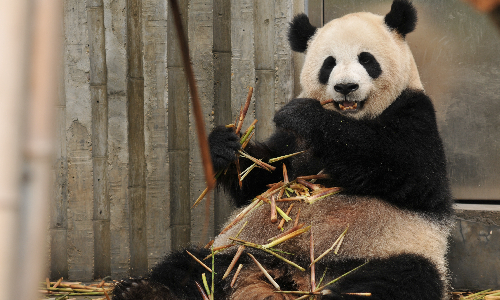
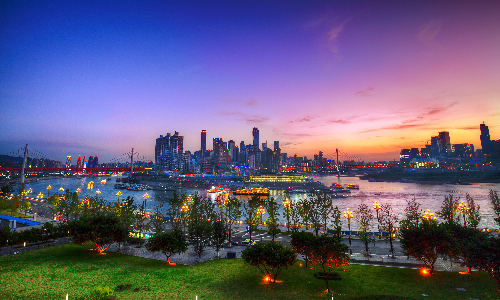
Today you can wake up naturally as we are not in a hurry. Then you can enjoy the buffet breakfast on the cruise ship. You can also participate in the Tai Chi activities in the morning. Tai Chi is a traditional Chinese sports activity. It emphasizes the harmony between a person's internal breathing and external body. Its movements are gentle and slow, suitable for everyone to participate. There is a Tai Chi teacher on board. You can also ask him more questions about Tai Chi if you are interested. After breakfast, you can drink a cup of coffee on the deck while enjoying the beautiful scenery. Today you will have a short excursion to visit Fengdu “Jade Emperor”, a world Taoist culture sightseeing Tourist site. According to World Taoism, the Jade Emperor is the head of the gods in China and has the highest status. This is a scenic area that combines Chinese culture and natural scenery. In addition, the scenic spot provides visitors a wide vision, where visitors can enjoy the beauty of the Yangtze River from a close distance.
Then it will be an additional excursion tour to Fengdu “Ghost City” (you should pay an extra charge on the cruise ship if you want to join it). There are shrines, temples, and monasteries. Imitating the netherworld, Fengdu “Ghost City” also has buildings and statues that are related to hell, a concept taken from Buddhism and Chinese mythology. Based on Chinese beliefs, in order to metempsychosis, the dead must pass three tests. One of them is a stone bridge that will test for good and evil. Good people will pass the bridge successfully, but evil people will be pushed down into hell under the bridge. Here in the Fengdu “Ghost City” Scenic Area, you will also see the replica of this Stone Bridge. Demon performers will momentarily stop visitors to pass the bridge, but they will allow them across in the end. The Hometown Tower here was built in 1985. According to the legend: the dead can get a last look at their homes and families on this tower.
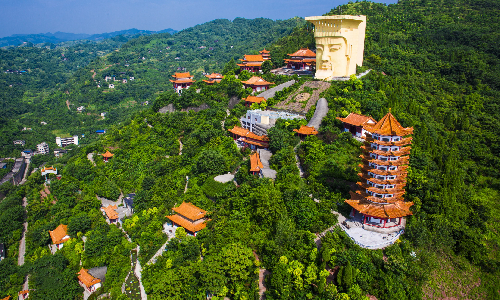
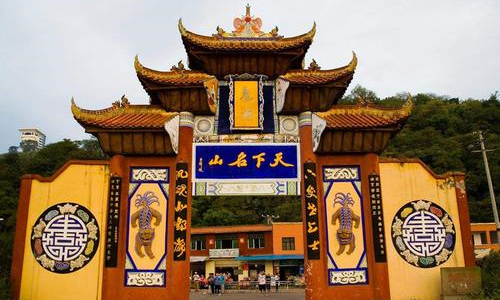
This morning you will enjoy the buffet breakfast. Today, we will pass the Three Gorges: Qutang Gorge, Wu Gorge, Xiling Gorge.
When you reach Wu Gorge, we will move to a small boat to visit Goddess Stream. It is a newly developed scenic spot in the process of carrying out the Three Gorges Project. With high mountains and deep valleys, the currents here are quite turbulent. Here you will see the Palm Peak, meaning the Buddha’s extended upward palm.
And then you will pass by the Qutang Gorge. Among the world-famous Three Gorges of the Yangtze River, Qutang Gorge is the shortest and narrowest section, but it is also the most majestic and magnificent section. On the precipice of the north bank, there is a relic of an ancient plank. In ancient times, in addition to the waterway, this ancient plank road hanging on the cliff was the only thing that could be connected to the outside world.
After appreciating the view in Qutang Gorge, you will see White Emperor City, the “City of Poems”. That’s because many poets have written famous and talented poets here, such as Du Fu and Li Bai. It is an ancient fortress on the northern shore of the Yangtze River. It is said that the area was surrounded by a white mist, making it quite mysterious.
At night, there will be a farewell dinner held by the captain. Enjoy yourself on the cruise ship.
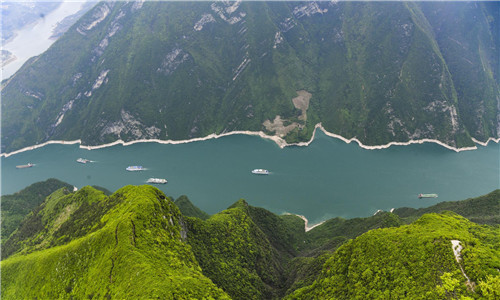
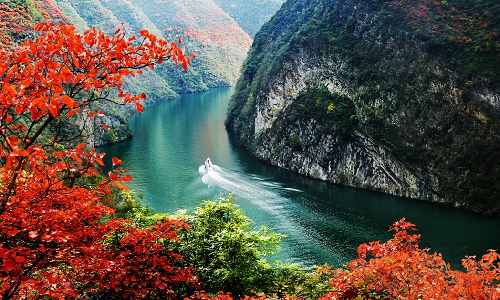
 Shanghai
Shanghai Today will be the last day on the cruise ship. After breakfast, you will visit the Three Gorges Dam Site. This is the largest hydropower project in the world. In the exhibition hall, you will learn more about the Three Gorges Dam. On the viewing platform in the scenic area, you can better appreciate the spectacular Three Gorges scenery. And then you will be transferred to the Yichang Three Gorges Center Cruise Terminal. Then your guide will pick you up and send you to Yichang railway station. You will take the estimated train D354 14:46/22:21 to Shanghai. Your Shanghai guide will pick up you at the train station and send you to your hotel. Have a good rest.
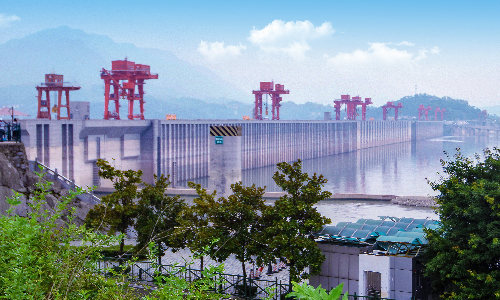
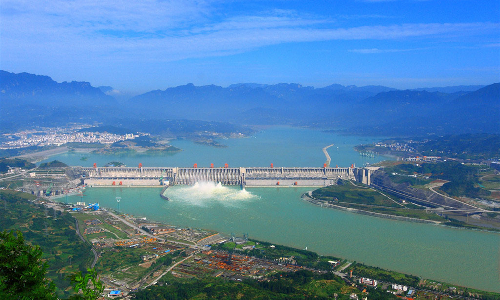
In the morning, you will visit Yu Garden (closed on each Monday). It was built in 1559 by Pan Yunduan, an officer at that time, for his aged father. Later Pan’s family declined and cannot afford the large expense so the garden was passed to different owners afterward. In 1780, the West Garden of Yu Garden was opened to the public. Yu Garden comprises six general areas: Sansui Hall, Wanhua Chamber, Dianchun Hall, Huijing Hall, Yuhua Hall, and Inner Garden. Till now, Yu Garden has been the place for kind of activities such as hiking activities, the lantern fair, painting exhibitions. If you are interested in carvings, paintings, or ancient Chinese furniture, Yu Garden, with its abundant collections of cultural relics, is the best place for you.
Then you will move on to visit Shanghai Old Street, where you seem to go back to the bustling market 100 years ago in Shanghai. It has gathered a number of Shanghai's earliest wine shops, tea houses, gold shops, food stores, and theaters. Here you can visit antique shops, buy specialty products such as silk, silver ornaments, and pastries.
After lunch, you will visit Shanghai Tower, a super high-rise landmark skyscraper in Shanghai, and its design height exceeds that of the nearby Shanghai World Financial Center. Like most modern skyscrapers, the Shanghai Tower is more than just an office building. Each of the Shanghai Tower's nine districts has its own sky lobby and atrium. And there are retail outlets and restaurants on every floor of the sky lobbies. In addition, there is also a hotel and sightseeing hall in the Shanghai Tower. Taking the elevator to the 118th floor. And you can enjoy a panoramic view of Shanghai City there. Meanwhile, Shanghai Tower is an environmental super high-rise building with its numerous environmental architecture elements. For example, it is designed to collect rainwater for internal use.
Next, you will see Nanjing Road, one of the busiest shopping streets in the world. The street is running in a west-east direction with its eastern section extending from The Bund to People’s Square. Here is filled with everything from antiques to snacks. An array of hotels and restaurants also can be seen here. Undoubtedly, it is a paradise for shoppers.
And then we will go to the Bund, a must-visit tourist attraction around here. It was a treaty port between the 1860s and the 1930s and had unparalleled status in Shanghai. Around the turn of the 20th century, many magnificent commercial buildings sprung up here. Walking along the bund, you will appreciate the fascinating architectural complexes here. Don’t forget to take some pictures and share them on your Facebook. I am sure that will attract lots of followers for you.
Option: You can also take a Huangpu River Night Cruise. The cruise ships vary in design, size, facilities, and passenger capacity, but most have comfortable seats and a sun deck, which will bring you a comfortable experience. At night, the cruise will bring you to go through the heart of Shanghai and will show you Shanghai’s one-of-a-kind integration of old and new.
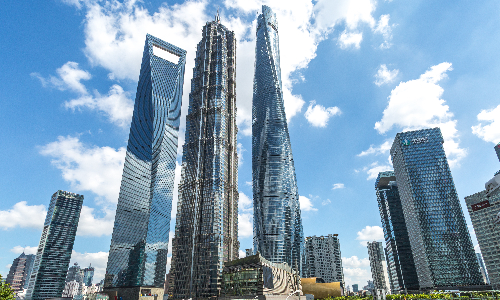
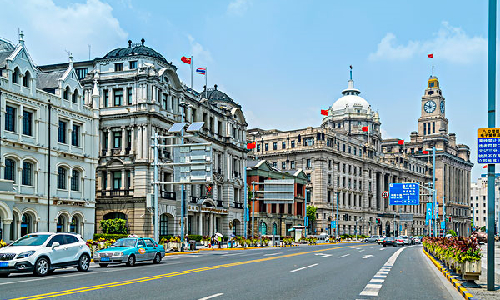
Your 13 days tour in China comes to an end and you will say goodbye to the country today. We will transfer you to the airport. During the 13 days, we appreciate your cooperation and understanding, and look forward to serving you next time!
Author: Shijin Chang
Proofreader: Betsy He
| City | Five Star hotel list | Four Star hotel list |
|---|---|---|
| Beijing | Sunworld Dynasty Hotel Beijing Wangfujing | Sunworld Hotel Wangfujing |
| Xi'an | Tianyu Gloria Grand Hotel Xi'an | Sunworld Dynasty Hotel |
| Chengdu | Sofitel Chengdu Taihe | Holiday Inn Express Chengdu Jinniu |
| Yangtze River Cruise | Victoria Anna | Victoria Anna |
| Shanghai | Ocean Hotel Shanghai | Courtyard by Marriott Shanghai Central |
 |
![]() About your child or infant, please contact us for a discounted price.
About your child or infant, please contact us for a discounted price.



We started with a few days in Beijing & ended in Shanghai, from where we visited the Forbidden City and Great Wall. In between we visited Terra Cotta Warriors Museum, Panda Base, Shanghai Disneyland.

We had a wonderful holiday in China which will remain long in the memory. China is a breathtakingly beautiful country full of splendid temples and palaces, mountains and rivers, peaceful rural scenes and bustling shopping streets.
 QUICK ENQUIRY
QUICK ENQUIRY